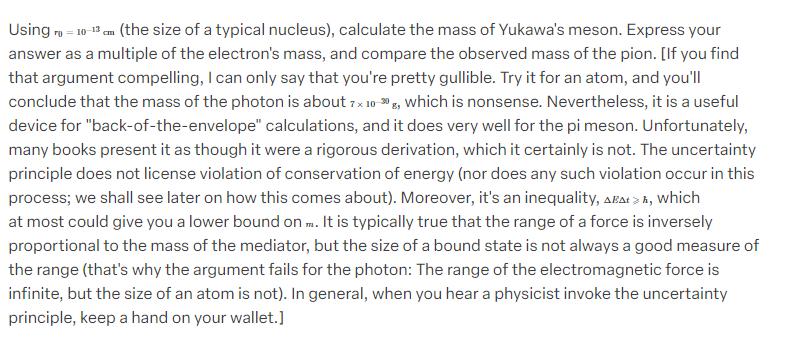Answered step by step
Verified Expert Solution
Question
1 Approved Answer
The mass of Yukawa's meson can be estimated as follows. When two protons in a nucleus exchange a meson (mass m.) they must wemporarily


The mass of Yukawa's meson can be estimated as follows. When two protons in a nucleus exchange a meson (mass m.) they must wemporarily violate the conservation of energy by an amount me (the rest energy of the meson). The Heisenberg uncertainty principle says that you may "borrow" an energy AB, provided you "pay it back" in a time A given by APA = (where = /2x). In this case we need to borrow AB=m long enough for the meson to make it from one proton to the other. It has to cross the nucleus (size), and it travels, presumably, at some substantial fraction of the speed of light, so, roughly speaking, At=/c. Putting this all together, we have 77 h roc Using To = 10-13 cm (the size of a typical nucleus), calculate the mass of Yukawa's meson. Express your answer as a multiple of the electron's mass, and compare the observed mass of the pion. [If you find that argument compelling, I can only say that you're pretty gullible. Try it for an atom, and you'll conclude that the mass of the photon is about 7 x 10-30g, which is nonsense. Nevertheless, it is a useful device for "back-of-the-envelope" calculations, and it does very well for the pi meson. Unfortunately, many books present it as though it were a rigorous derivation, which it certainly is not. The uncertainty principle does not license violation of conservation of energy (nor does any such violation occur in this process; we shall see later on how this comes about). Moreover, it's an inequality, ABAt >h, which at most could give you a lower bound on m. It is typically true that the range of a force is inversely proportional to the mass of the mediator, but the size of a bound state is not always a good measure of the range (that's why the argument fails for the photon: The range of the electromagnetic force is infinite, but the size of an atom is not). In general, when you hear a physicist invoke the uncertainty principle, keep a hand on your wallet.]
Step by Step Solution
★★★★★
3.51 Rating (158 Votes )
There are 3 Steps involved in it
Step: 1

Get Instant Access to Expert-Tailored Solutions
See step-by-step solutions with expert insights and AI powered tools for academic success
Step: 2

Step: 3

Ace Your Homework with AI
Get the answers you need in no time with our AI-driven, step-by-step assistance
Get Started


